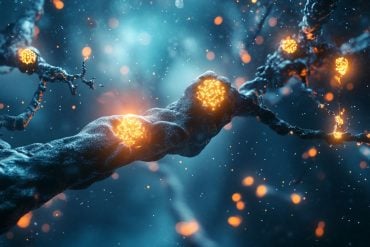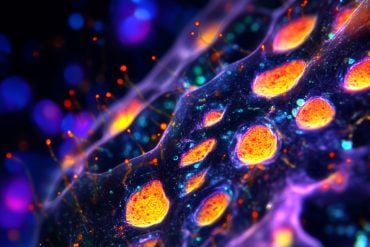Summary: High levels of anthranilic acid in the blood may be a new biomarker for assessing the risk of developing major depressive disorder.
Source: Fujita Health University
Chronic pain, or inflammation, is believed to be one of the major factors in the onset of major depressive disorder. Therefore, to better understand what happens physiologically during depression, scientists have long studied several metabolic processes or “pathways” related to inflammation. One of these pathways, called the kynurenine pathway, is the principal pathway involved in metabolizing the amino acid tryptophan. Now, a new study by a team of scientists, led by Professor Kuniaki Saito and Associate Professor Yasuko Yamamoto of Japan’s Fujita Health University, shows that elevated levels of anthranilic acid–an important metabolite (product/intermediate) of the kynurenine pathway–in the blood may serve as a marker for identifying individuals who are experiencing depression-like symptoms and are at risk of developing major depressive disorder.
This interesting new study is published in Scientific Reports.
“Various lines of scientific evidence suggest that tryptophan metabolism is involved in the symptoms of major depressive disorder,” notes Dr Yamamoto.
For example, past studies have reported that patients with depression and other conditions involving depression-like symptoms show increased blood levels of various tryptophan metabolites produced by the kynurenine pathway. These findings led Dr Saito’s team to speculate that metabolites of the kynurenine pathway may serve as “biomarkers” that could allow early detection of patients at risk of developing depression.
To test this idea, Dr Saito’s team analyzed serum (fractionated, clear part of blood) samples from 61 patients who had clinical test scores that indicated a high risk of developing major depressive disorder. For scientifically accurate comparison, they also used a “control” group, wherein they analyzed serum samples from 51 healthy individuals. The scientists measured the serum levels of various kynurenine pathway metabolites with a technique called high-performance liquid chromatography, which allows precise measurement of concentrations. Compared to the healthy “controls,” the patients at risk of depression had increased serum levels of anthranilic acid. Furthermore, the women at risk of depression had reduced serum levels of tryptophan. Given that the kynurenine pathway consumes tryptophan and produces anthranilic acid, these findings are aligned with the previous findings of increased kynurenine pathway activity in patients at risk of developing major depressive disorder.
The scientists also wanted to find out whether tryptophan metabolite profiles can predict the progression of depression-related symptoms. For that, they did further analyses on samples and data from 33 patients at risk of depression whose scores on a clinical depression scale at different timepoints indicated regression from a healthy state to a depressed state. The analyses showed that increases in serum anthranilic acid levels over time correlated with worsening of the clinical test scores. Prof Saito states, “this finding confirms that there is indeed a strong, direct correlation between anthranilic acid levels in blood and the severity of depression on the clinical depression scale.”

Because chronic pain can cause depression and related symptoms, the scientists also scrutinized tryptophan metabolite profiles in patients with chronic pain disorders affecting the mouth, jaw, and face. By testing serum samples from 48 patients with chronic pain disorders and 42 healthy individuals, the research team found that the patients with chronic pain had elevated serum levels of anthranilic acid and lower serum levels of tryptophan, just like those who were at risk of major depressive disorder.
So, what is the takeaway of this study? According to Prof Saito and team, these results show that clinicians can monitor serum levels of anthranilic acid to find out if patients are at risk of developing major depressive disorder. As Prof Saito notes, “monitoring the levels of tryptophan metabolites may be useful for the realization of pre-emptive medicine for depressive symptoms.” Preemptive medicine in this case involves specific treatments that can prevent a patient from developing depression. Of course, more research is necessary to validate the clinical relevance of serum anthranilic acid levels and to understand exactly how tryptophan metabolism influences outwardly aspects like mood. But, that said, this study has the potential to pinpoint the physiological processes that contribute to depression and thus improve the standard of care for preventing depression.
Source:
Fujita Health University
Media Contacts:
Yasuko Yamamoto – Fujita Health University
Image Source:
The image is credited to Fujita Health University.
Original Research: Open access
“Serum Metabolic Profiles of the Tryptophan-Kynurenine Pathway in the high risk subjects of major depressive disorder”. Masashi Sakurai, Yasuko Yamamoto, Noriyo Kanayama, Masaya Hasegawa, Akihiro Mouri, Masao Takemura, Hidetoshi Matsunami, Tomoya Miyauchi, Tatsuya Tokura, Hiroyuki Kimura, Mikiko Ito, Eri Umemura, Aiji Sato (Boku), Wataru Nagashima, Takashi Tonoike, Kenichi Kurita, Norio Ozaki, Toshitaka Nabeshima & Kuniaki Saito.
Scientific Reports doi:10.1038/s41598-020-58806-w.
Abstract
Serum Metabolic Profiles of the Tryptophan-Kynurenine Pathway in the high risk subjects of major depressive disorder
Previous reports have shown that during chronic inflammation, the tryptophan (TRP)-kynurenine (KYN) pathway plays a pivotal role in the onset of depression. The aim of this study was to investigate the characteristics of the serum TRP-KYN pathway metabolite profile in high-risk subjects of major depressive disorder (HRMDD) defined by depression scores. The concentrations of TRP-KYN pathway metabolites {TRP, KYN, 3-hydroxyanthranilic acid (3HAA), 3-hydroxykynurenine (3HK), kynurenic acid (KYNA) and anthranilic acid (AA)} were assessed in serum from HRMDD, chronic pain disorder patients and healthy controls. In serum from HRMDD, elevated levels of AA and decreased levels of TRP were observed, but the levels of other metabolites were not changed. Furthermore, the change in the AA2nd/AA1st ratio in subjects who progressed from a health. y state to a depressive state was correlated with an increase in the CES-D score. The level of IL-1 receptor antagonist (IL-1RA) was negatively correlated with that of AA. Interestingly, we confirmed AA as a possible biomarker for depression-related symptoms, since the metabolite profiles in the chronic pain disorder group and chronic unpredictable mild stress model mice were similar to those in the HRMDD. These results suggest that AA may be an effective marker for HRMDD.






